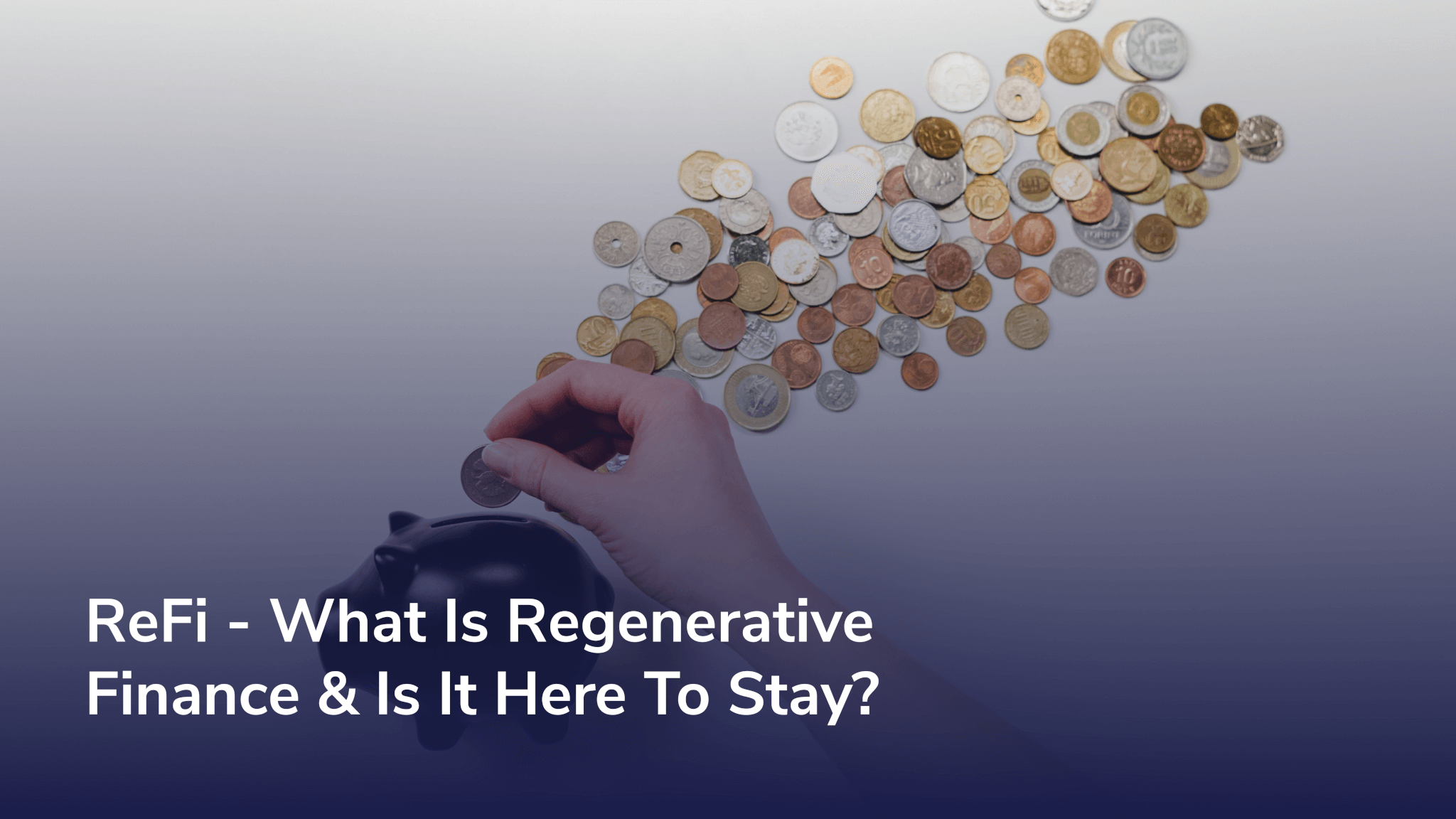During the past year, the idea of regenerative finance has gained increasing attention in the world of sustainable investment. As businesses start acknowledging the relevance of a holistic alignment of financial strategies with environmental and social goals, regenerative finance is one of the solutions that come to mind, as it offers a promising and future-oriented framework for driving sustainable change.
In order to assess whether this is going to be the next big trend in sustainable development and the adoption of sustainable practices in the business world, we first need to understand its underlying principles, the benefits it opens as well as the current state and challenges when it comes to its adoption.
But What Is Regenerative Finance?
Regenerative finance goes beyond traditional sustainable investing by focusing on creating positive impacts that go hand in hand with financial returns. It seeks to address environmental, social, and economic challenges through innovative investment strategies that promote regeneration and resilience. While the associations with this topic usually stop at greenhouse emissions and carbon footprint, its underlying principles are about much more than that, providing a macroeconomic framework based on sustainable principles.
One of these, while it sounds a little academic, is actually a key principle – holistic systems thinking means recognizing the interconnectedness of economic, social, and environmental systems. It aims to address systemic challenges by considering the long-term consequences of financial decisions. Another principle that helps define this concept is related to measuring impact and to being accountable. The measurement of positive environmental and social impacts is a vital aspect of regenerative finance – by adopting clear metrics and reporting standards, investors can assess the effectiveness of their investments in generating positive change.
It goes without saying that all of this has to go through a very complex filter of collaboration and community adoption, with an emphasis on the importance of engaging local communities. By involving stakeholders and understanding their needs, investors can ensure that their initiatives contribute to the well-being of both people and the planet. Technology plays a pivotal role in driving regenerative finance. From blockchain solutions to streamline impact investing to advanced data analytics for measuring outcomes, innovation is key to unlocking the full potential of regenerative finance.
But will it be the next big thing?
The Current State of Regenerative Finance
While regenerative finance holds great promise, its adoption is still in the early stages. The financial industry is gradually recognizing the potential of regenerative finance, but widespread implementation remains a work in progress. However, there are notable developments and initiatives that highlight the growing interest in this approach:

- Rise of impact investing – this type of investment has gained lots of momentum in recent years, with more investors seeking financial returns alongside positive social and environmental impacts. This shift in investor mindset aligns with the principles of regenerative finance.
- Integration of ESGs – you know them: environmental, social, and governance factors are increasingly integrated into investment decisions, in a trend that indicates a broader shift towards sustainable investing, which aligns with the regenerative finance philosophy.
- Innovative financial instruments – now the emergence of innovative financial instruments, such as green bonds, social impact bonds, and sustainability-focused funds is not as widespread as it should be to demonstrate global adoption, but it does show a growing appetite for investments that generate positive change.
- Collaboration between investors and businesses – this is starting to take off, in the sense that more and more investors partner up with local businesses to drive regenerative finance initiatives. This partnership fosters innovation, facilitates knowledge sharing, and enhances the potential for scalable impact.
The Key Players in Regenerative Finance
Regenerative finance is gaining traction across various sectors and attracting a diverse range of players, who might be the pioneers of this type of technology. Impact investors are the people who actively seek investments that generate positive social and environmental outcomes alongside financial returns. What they do to further this cause can drive capital towards projects and companies aligned with regenerative principles.
Re-Fi definitely holds the potential to transform economic systems as we know them. It can do this by addressing pressing global issues and, consequently, by fostering sustainable development as a standard practice.
There’s no telling what we can do by the adoption of Re-Fi. First of all, we can drive innovation by encouraging innovative approaches to sustainability challenges in an active and an intentional way. Once financial incentives are aligned with positive social and environmental outcomes, both businesses and investors would theoretically have the financial incentives they need to start focusing on creating solutions that benefit not just their bottom line, but the planet as well.
Then, there are the financial institutions. Increased adoption by banks, asset management firms, and other financial institutions are increasingly integrating regenerative finance into their operations would theoretically mean more access to funding, expertise, and financial products that support sustainable initiatives, fostering the growth of regenerative finance.
Now financial institutions usually further the cause of sustainable entrepreneurs, or at least this is the way through which a first contact with the world of re-fi is going to be initiated at a higher institutional level. Sustainable entrepreneurs are businesses committed to sustainability and what we generally call catalysts. They innovate and develop solutions that address pressing environmental and social challenges while generating financial value.
The mobilization of capital is another challenge in and of itself. The scale to which these practices would have to mobilize resources in order to drive some meaningful impact is astronomical by today’s standard. But it’s not impossible, especially since we’ve started to pay attention to developing a sense of resilience when it comes to our financial ecosystems. By fostering sustainable practices, it helps mitigate risks associated with environmental degradation, social inequality, and, why not, economic volatility.
Another key player that could help regenerative finance be the next trend are policy makers, both globally and locally. They don’t just play a critical role in creating an enabling environment for regenerative finance, but they’re the ones who can further regulations, incentives, and frameworks that encourage sustainable practices and investments.
While systemic change is an awfully hard thing to drive, regenerative finance has the potential to address the root causes of social and environmental issues. This way, it can help enable investments in different types of projects of different scales, to tackle these challenges and to come up with creative solutions.
Regenerative finance is evolving super fast, and it’s driven by emerging trends and market dynamics, such as impact measurement and data, for instance. The focus on robust impact measurement and data-driven decision-making gains prominence. Standardized frameworks and advanced analytics empower stakeholders to quantify and communicate the positive impacts of regenerative finance initiatives.

From blended finance combining public and private capital, to nature-based solutions such as reforestation or ecosystem restoration and sustainable agriculture, all of these align with the principles of regenerative finance. Not to mention the very popular circular economy, whose focus is precisely to minimize waste and maximize resource efficiency. As business embrace these practices, investors become more open to actively supporting them.
The Road Ahead for Re-Fi
Regenerative finance has a huge potential to impact our future, not just in terms of the financial industry bubble, but also at a more mainstream level. Right now there still are several challenges to overcome for this to become a reality. Until its widespread adoption, the following are still issues to be addressed:
- Standardization of impact metrics: consistent impact measurement and reporting frameworks – they are crucial for building trust and ensuring transparency within the regenerative finance ecosystem, and it’s going to be a learning curve for all practitioners to create these frameworks and to support them in a collaborative manner.
- Education and awareness: promoting this new paradigm (as it is a new paradigm!) and educating stakeholders about the benefits and principles of regenerative finance is essential when it comes to encouraging wider adoption and overcoming misconceptions about its applicability.
- Policy and legal support: governments and regulatory bodies are generally slower in the adoption of new frameworks, but they can definitely play a vital role in creating an enabling environment for regenerative finance. Policies to incentivize sustainable investments and to provide regulatory clarity can become the reason why we accelerate growth, and they can single handedly impress this into the mainstream frameworks.
- Technology, evidently: thorough and supported investment in technological advancements solutions is going to be instrumental in scaling regenerative finance. The way the business landscape decides to leverage emerging technologies has a huge impact on streamlining the whole process.

Regenerative finance represents a promising shift towards a more sustainable and inclusive financial system.
While it is still in its early stages, there is growing momentum and interest in adopting. By embracing the principles of regenerative finance, investors can now unlock the opportunity to generate positive impacts while achieving financial returns. Of course, it will take collaboration and a great deal of commitment towards long-term thinking in order to realize the full potential of Re-Fi and to create a more sustainable future for the upcoming generation, but the trend is starting to take shape and it’s slowly immersing itself into mainstream practices.


